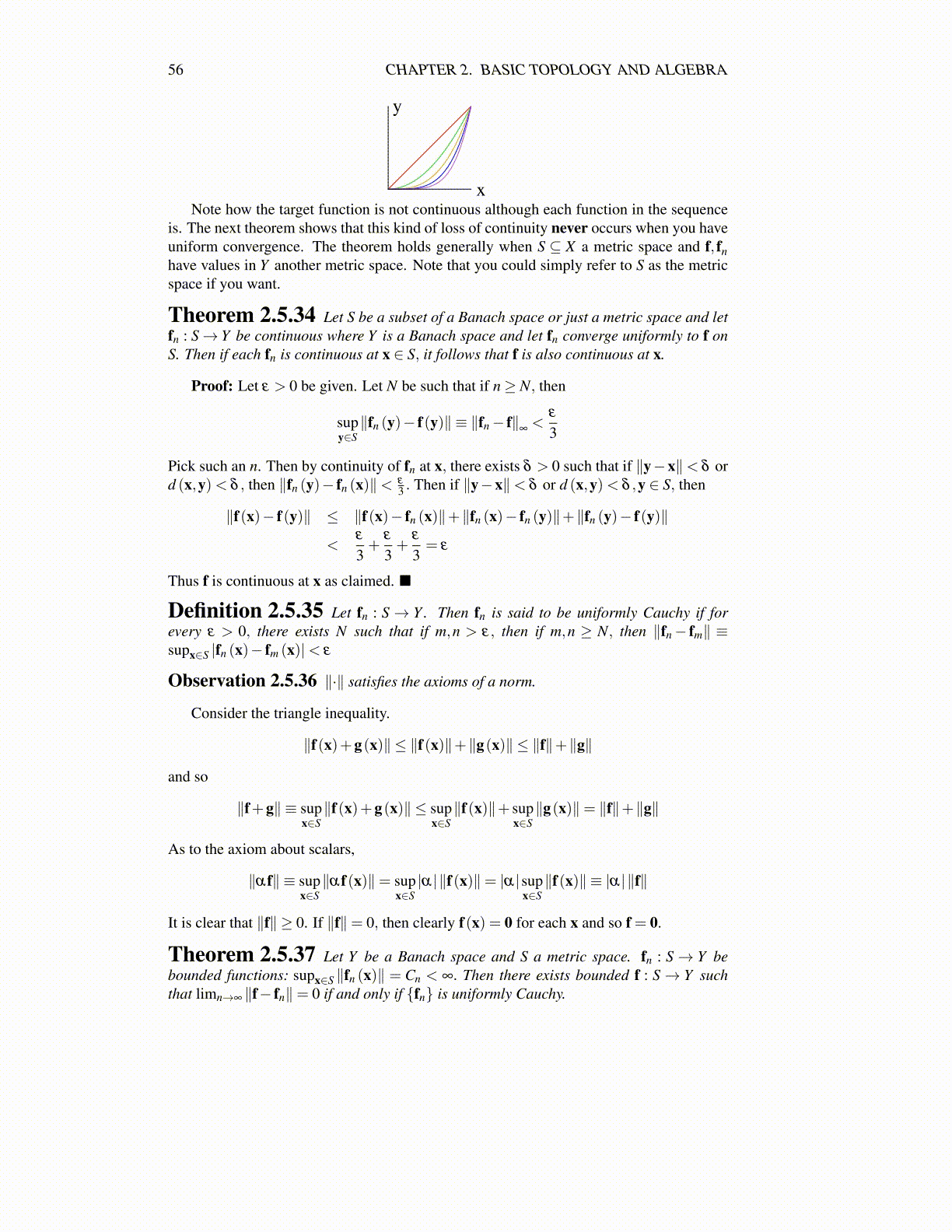
56 CHAPTER 2. BASIC TOPOLOGY AND ALGEBRA
x
y
Note how the target function is not continuous although each function in the sequenceis. The next theorem shows that this kind of loss of continuity never occurs when you haveuniform convergence. The theorem holds generally when S ⊆ X a metric space and f, fnhave values in Y another metric space. Note that you could simply refer to S as the metricspace if you want.
Theorem 2.5.34 Let S be a subset of a Banach space or just a metric space and letfn : S→ Y be continuous where Y is a Banach space and let fn converge uniformly to f onS. Then if each fn is continuous at x ∈ S, it follows that f is also continuous at x.
Proof: Let ε > 0 be given. Let N be such that if n≥ N, then
supy∈S∥fn (y)− f(y)∥ ≡ ∥fn− f∥
∞<
ε
3
Pick such an n. Then by continuity of fn at x, there exists δ > 0 such that if ∥y−x∥< δ ord (x,y)< δ , then ∥fn (y)− fn (x)∥< ε
3 . Then if ∥y−x∥< δ or d (x,y)< δ ,y ∈ S, then
∥f(x)− f(y)∥ ≤ ∥f(x)− fn (x)∥+∥fn (x)− fn (y)∥+∥fn (y)− f(y)∥
<ε
3+
ε
3+
ε
3= ε
Thus f is continuous at x as claimed. ■
Definition 2.5.35 Let fn : S→ Y . Then fn is said to be uniformly Cauchy if forevery ε > 0, there exists N such that if m,n > ε, then if m,n ≥ N, then ∥fn− fm∥ ≡supx∈S |fn (x)− fm (x)|< ε
Observation 2.5.36 ∥·∥ satisfies the axioms of a norm.
Consider the triangle inequality.
∥f(x)+g(x)∥ ≤ ∥f(x)∥+∥g(x)∥ ≤ ∥f∥+∥g∥
and so
∥f+g∥ ≡ supx∈S∥f(x)+g(x)∥ ≤ sup
x∈S∥f(x)∥+ sup
x∈S∥g(x)∥= ∥f∥+∥g∥
As to the axiom about scalars,
∥αf∥ ≡ supx∈S∥αf(x)∥= sup
x∈S|α|∥f(x)∥= |α|sup
x∈S∥f(x)∥ ≡ |α|∥f∥
It is clear that ∥f∥ ≥ 0. If ∥f∥= 0, then clearly f(x) = 0 for each x and so f = 0.
Theorem 2.5.37 Let Y be a Banach space and S a metric space. fn : S→ Y bebounded functions: supx∈S ∥fn (x)∥ = Cn < ∞. Then there exists bounded f : S→ Y suchthat limn→∞ ∥f− fn∥= 0 if and only if {fn} is uniformly Cauchy.